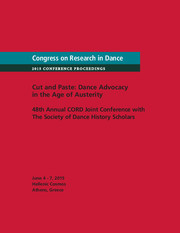No CrossRef data available.
Article contents
Theorizing Hybridity and Identity: The “Edge-Effect” and “Dynamic Nucleus” in Bharatanatyam-Inspired Contemporary Dances of Two Choreographers
Published online by Cambridge University Press: 05 December 2013
Abstract
Dancer-choreographer Nova Bhattacharya uses the ecological term “edge-effect” to describe her experience within the choreographic process where her bharatanatyam training and her contemporary dance creativity overlap to create a lingua franca. Hari Krishnan, dancer-choreographer and scholar, describes his work as “constantly ruptured” within his “post-post-modern experience.” This paper argues that the creative processes underlying the respective contemporary dance-making practices of Nova Bhattacharya and Hari Krishnan are cultural ecosystems demonstrating the rich dynamic of the edge-effect at the intersection of bharatanatyam and contemporary dance aesthetics and themes. Within the edge-effect, both reception and rupture occur as artistic identities evolve. Furthermore, reception and rupture occur within the performance venue as the performers' and audiences' worlds overlap—another negotiated edge-effect. While the ecological metaphor of the edge-effect helps to conceptualize these interactive spaces, the sociological metaphor of a “dynamic nucleus” (Lloyd Wong) helps us to theorize the nature and energy of the critically reflective exchanges occurring, between contemporary and bharatanatyam sensibilities, in both the studio and concert theater. The edge-effect and dynamic nucleus metaphors build on Homi Bhaha's concept of the “cultural interstices” within which individual and communal identities are initiated and culture is located. Additionally, these metaphors expand on Guillermo Gômez-Peña's theory of “multihybrid identities, in a constant process of metamorphosis” as today's “border-culture” becomes tomorrow's institutional art. This paper provides dance scholars with a way of conceptualizing the energy of dance as a cultural force influencing experiences of hybridity and identity for performers and audiences within intercultural contexts.
- Type
- Research Article
- Information
- Copyright
- Copyright © Cheryl LaFrance 2012


